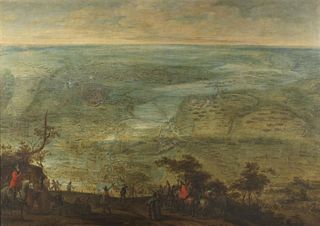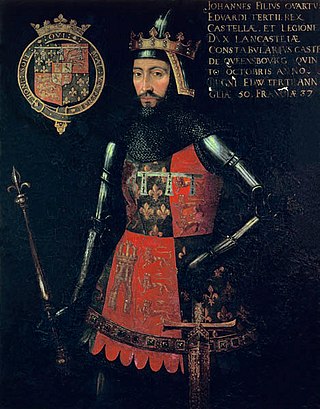
Thomas de Beauchamp, 11th Earl of Warwick, KG, sometimes styled as Lord Warwick, was an English nobleman and military commander during the Hundred Years' War. His reputation as a military leader was so formidable that he was nicknamed 'the devil Warwick' by the French. In 1348 he became one of the founders and the third Knight of the Order of the Garter.

The Battle of Castillon between the forces of England and France took place on 17 July 1453 in Gascony near the town of Castillon-sur-Dordogne. Historians regard this decisive French victory as marking the end of the Hundred Years' War.
A chevauchée was a raiding method of medieval warfare for weakening the enemy, primarily by burning and pillaging enemy territory in order to reduce the productivity of a region, in addition to siege warfare most often as part of wars of conquest but occasionally as a punitive raid. The use of the chevauchée declined at the end of the 14th century as the focus of warfare turned to sieges. It is conceptually similar to the scorched earth strategies used in modern warfare.

The Battle of the Monongahela took place on July 9, 1755, at the beginning of the French and Indian War at Braddock's Field in present-day Braddock, Pennsylvania, 10 miles (16 km) east of Pittsburgh. A British force under General Edward Braddock, moving to take Fort Duquesne, was defeated by a force of French and Canadian troops under Captain Daniel Liénard de Beaujeu with its American Indian allies.

James I of Bourbon, was a French prince du sang, and the son of Louis I, Duke of Bourbon and Mary of Avesnes. He was Count of Ponthieu from 1351 to 1360, and Count of La Marche from 1341 to his death.
The Battle of Saintes was fought on 1 April 1351 during the Hundred Years' War between French and English forces. The French were besieging the town of Saint-Jean-d'Angély when an English relief force arrived. The English force was victorious, but the battle was not able to force the end of the siege of Saint-Jean-d'Angély, which fell to the French on 31 August.
The Battle of Mauron was fought in 1352 in Brittany during the Breton War of Succession between an Anglo-Breton force supporting the claim of Jean de Montfort and a Franco-Breton force supporting the claim of Charles de Blois. The Anglo-Bretons were victorious. The battle took place in the context of the Hundred Years War.

The Battle of Saint-Omer, fought on 26 July 1340, was a major engagement in the early stages of the Hundred Years' War, during Edward III's 1340 summer campaign against France launched from Flanders. The campaign was initiated in the aftermath of the English naval victory at the Battle of Sluys but was far less successful than Edward had hoped. At Saint-Omer, the heavily-outnumbered French men-at-arms, tasked with defending the city and awaiting reinforcements, unexpectedly defeated the Anglo-Flemish forces on their own. The allies suffered heavy losses and the French captured their camp intact, taking many warhorses, draft animals and carts, all the tents, huge quantities of supplies and most of the Flemish standards. Edward's campaign of 1340 had begun badly. On the bright side, the loss of several thousand men was bearable, as the survivors, which included most of the precious English longbowmen, eventually rejoined him at Tournai. The defeat had serious strategic consequences. It exposed southern Flanders to the wrath of Philip VI and enabled the French to concentrate their forces against the main army of the coalition in the siege of Tournai.
Events from the 1360s in England.

The Battle of Pontvallain, part of the Hundred Years' War, took place in the Sarthe region of north-west France on 4 December 1370, when a French army under Bertrand du Guesclin heavily defeated an English force which had broken away from an army commanded by Sir Robert Knolles. The French numbered 5,200 men, and the English force was approximately the same size.

The siege of Saint-Omer was a siege in the Thirty Years' War in which a French army under Gaspard III de Coligny, Maréchal de Châtillon, laid siege to the Flemish city of Saint-Omer, defended by a small garrison in command of Lancelot II Schetz, count of Grobbendonck. Despite several initial successes in the capture of the minor forts around Saint-Omer, on the night of 8/9 June a Spanish relief army under Thomas Francis, Prince of Carignano surprised Châtillon's troops and established a small fort in the middle of the French lines. An entire army corps under Maréchal de La Force was ordered to move towards Saint-Omer to support Châtillon siege, but on 12 July a further Imperial-Spanish force commanded by Ottavio Piccolomini entered Saint-Omer, resolving the French marshals to withdraw.

The siege of Calais of 1596, also known as the Spanish conquest of Calais, took place at the strategic port-city of Calais, between 8 and 24 April 1596, as part of the Franco-Spanish War (1595–1598), in the context of the French Wars of Religion, the Anglo-Spanish War (1585–1604), and the Eighty Years' War. The siege ended when the city fell into Spanish hands after a short and intense siege by the Spanish Army of Flanders commanded by Archduke Albert of Austria, Governor-General of the Spanish Netherlands. The French troops in the citadel of Calais resisted for a few days more but finally, on 24 April, the Spanish troops led by Don Luis de Velasco y Velasco, Count of Salazar, assaulted and captured the fortress, achieving a complete victory. The Spanish success was the first action of the campaign of Archduke Albert of 1596.

The Battle of Calais took place in 1350 when an English force defeated an unsuspecting French army which was attempting to take the city. Despite a truce being in effect the French commander Geoffrey de Charny had planned to take the city by subterfuge, and bribed Amerigo of Pavia, an Italian officer of the city garrison, to open a gate for them. The English king, Edward III, became aware of the plot and personally led his household knights and the Calais garrison in a surprise counter-attack. The French were routed by this smaller force, with significant losses and all their leaders captured or killed.

Louis I de Poitiers, Count of Valentinois, was a 14th-century French noble. Louis was killed during the Battle of Auberoche in 1345.

Édouard I de Beaujeu a Marshal of France, Lord of Beaujeu and Montpensier was a 14th-century French noble.

The siege of Saint-Jean-d'Angély took place from February to August 1351 when a French army besieged an English garrison within the town of Saint-Jean-d'Angély, Saintonge, France during the Hundred Years' War. An English relief force was victorious at the Battle of Saintes, however was unable to relieve the town. With the personal appearance of King John II of France at the siege, the English garrison surrendered.
The Gascon campaign of 1450-1453 took place during the Hundred Years War when the kingdom of France undertook a military campaign to invade and cede the Duchy of Gascony from the English. Following the decisive victory of the French at the battle of Castillion and after the fall of Bordeaux, the last English stronghold in Gascony, English control of Gascony was removed.
The siege of Guînes took place from May to July 1352 when a French army under Geoffrey de Charny unsuccessfully attempted to recapture the French castle at Guînes which had been seized by the English the previous January. The siege was part of the Hundred Years' War and took place during the uneasy and ill-kept truce of Calais.

English offensives in 1345–1347, during the Hundred Years' War, resulted in repeated defeats of the French, the loss or devastation of much French territory and the capture by the English of the port of Calais. The war had broken out in 1337 and flared up in 1340 when the king of England, Edward III, laid claim to the French crown and campaigned in northern France. There was then a lull in the major hostilities, although much small-scale fighting continued.

John of Gaunt's chevauchée of 1373 was an English military raid at the end of the second period of the Hundred Years' War by John of Gaunt, Duke of Lancaster, from his departure from Calais in August 1373 to his arrival at Bordeaux at the end of December 1373.














